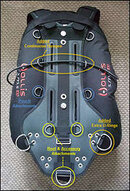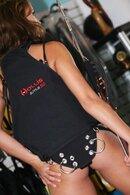Sorry guys but this post is very wrong, if you really want to save money then don’t switch to side mount, most of the real benefits for cave, wreck or open water are lost with the harness shown above?
If you want the benefits of sidemount, get an actual sidemount harness and the right training – otherwise, why change from backmount?
Karl, what I see in this post (and diving trends) is the results of PADI promoting sidemount as a main-stream option. People want to "try it", but don't want to make the investment/commitment towards buying a rig prior to that sampler/initial training. For non-specialist (tech/wreck/cave) divers, that can be understood. The merits of sidemount for open-water divers are quite intangible, other than personal comfort and a wealth of gas redundancy.
However, I do agree that the role of the training-provider is to actually serve the desire of sidemount students to 'try sidemount'... and that means investment in appropriate rental gear for students to use.
As an aside, the OMS Tesseract/Profile system
is an "actual sidemount system" - yet that comes (as standard) with a metal backplate.. and looks distinctly like the example given in this thead. The example given merely substitutes a second back-plate for the Profile Adapter system. I can imagine the diving 'feel' is similar. However, the system is far from ideal for confined spaces diving... but that's not what we're talking about (OP references 'open-water' specifically).
All my sidemount students thus far have been put into either Razor or Hollis rigs for training (or have arrived with their own) - and that includes recreational/open-water divers. I do have my 'first' student booked early next year who wants to undertake the course in a modified BP&W. That is/will take a lot more effort on my behalf - helping him configure and adapt what he has for his intended purposes (recreational wreck diving). You can (honestly) make a decent rig DIY... using existing components... but it takes considerable tinkering and adaptation. Not something I'd want to do with every sidemount student, but my courses are hardly 'off-the-shelf'.. much more mentoring involved.
My personal opinion is that the OP should make the ~$120 investment and put "proper" OMS adapters on his sidemount. It's a far better solution than a secondary back-plate, at little extra cost.... and, at least, it is a "proper" solution.
Lest we forget: sidemount is not yet set-in-stone and the Razor/UTD/X-Deep design isn't necessarily the only way to approach it






